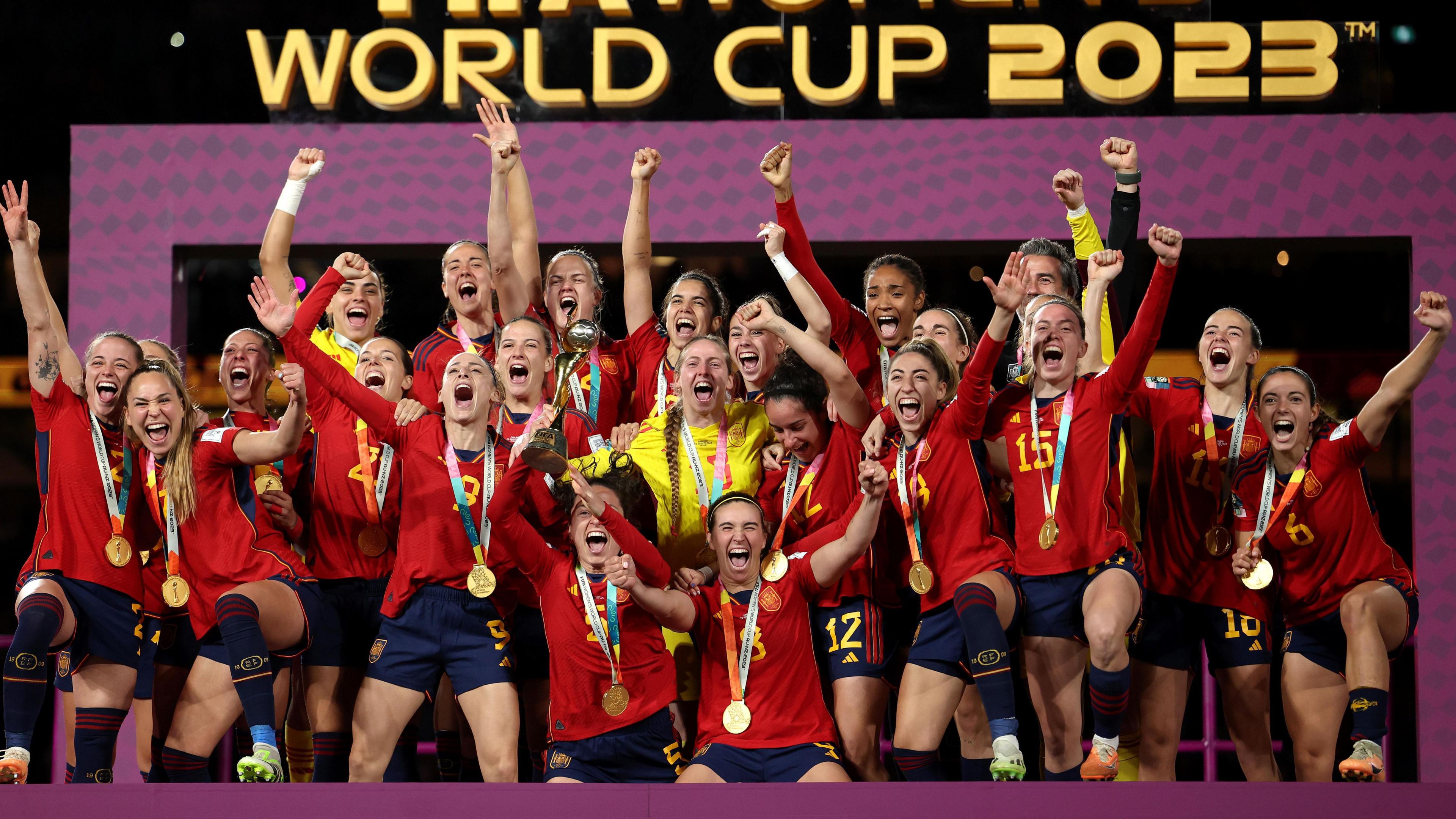Will 48-team Women's World Cup be good for the game?

Spain beat England in the 2023 final to win their first Women's World Cup
- Published
"Fifa was right."
That's how president Gianni Infantino described his organisation's decision to expand the Women's World Cup from 16 teams to 32 for the 2023 tournament.
Less than two years later Fifa has announced plans for further expansion.
The women's tournament will follow the lead of the men's World Cup and become a 48-team competition from 2031.
But is Fifa right this time? BBC Sport looks at the pros and cons of an expanded Women's World Cup.
Was expansion a success in 2023?
The 2023 World Cup in Australia and New Zealand, which featured eight new teams, threw up plenty of surprises.
It was a successful tournament for African nations, with underdogs Morocco, South Africa and Nigeria - ranked 72, 54 and 40 in the world respectively - reaching the last 16.
Morocco's progression came at the expense of two-time champions Germany, who went out at the group stages a year after reaching the Euro 2022 final.
Zambia, ranked 81st, were the lowest-ranked team to qualify.
While they suffered 5-0 losses to Japan and Spain, they finished third in their group thanks to a 3-1 win over Costa Rica, who were ranked 44 places higher.
Nigeria, 40th in the rankings, lost to eventual runners-up England in a penalty shootout in the last 16.
Of the 32 teams, only three failed to earn a single point - Costa Rica, Haiti and Vietnam - and only Vietnam failed to score.
There were some one-sided scorelines, though, including the Netherlands firing seven past Vietnam and Norway thrashing the Philippines 6-0.
What are the benefits?
Only 44 nations have played in a Women's World Cup.
With the tournament expanding by 16 teams, there will be more qualifying places allocated to each of the six Fifa continental zones.
That could provide an extra incentive for governments and national football associations - particularly from smaller nations who have not competed on the world stage - to invest in the women's game.
US Soccer chief executive JT Batson said the expansion of the 2031 tournament - set to be held in the US - would be "incredible for growing the women's game".
"One of the things we hear from folks who lead federations around the world is they view the Women's World Cup as an opportunity for them to, one, make a World Cup and, two, really go compete in a way that conceivably they wouldn't be able to on the men's side," Batson said., external
"So what this would lead to in terms of spurring investment all around the world in women's and girls' soccer, we think would be incredible."
England manager Sarina Wiegman said she had reservations about expanding from 24 teams to 32 for the 2023 edition.
However, she changed her mind after the tournament, saying more teams "made it more competitive".
"It will grow the game again in different countries because they have other opportunities to come and still have challenges to overcome," Wiegman said.
"Some countries are at different stages of their development, so it will empower women in sport, women in football and women in society."
From a UK perspective, more qualifying places would give the home nations a better chance of reaching a tournament on home soil in 2035.
While England have established themselves as one of the world's best teams, Scotland and the Republic of Ireland have played in only one World Cup, and Wales and Northern Ireland have never qualified.
Wales and Scotland lost in the play-off finals for the 2023 tournament.

Wales missed out on a first major tournament when Switzerland scored a late extra-time winner in the play-off finals for the 2023 World Cup
What are the downsides?
When it was announced that the men's World Cup would expand to 48 teams, the immediate concerns were that the competition would be diluted.
The same questions have been asked of an expanded Women's World Cup and there are worries that one-sided scorelines and a gulf in quality would devalue the women's game and turn off television audiences.
"There is the fear it might dilute some of the competition," said former England goalkeeper Karen Bardsley.
She also highlighted player welfare and adding to an already busy football calendar as possible downsides to an expanded tournament.
"There's probably also an element of will the tournament be longer? You're going to see a massive increase in games," she said.
"Will there be an increase in rest periods? How is that going to affect the domestic calendar? How is that going to affect the player loading and recovery?"
Qualifying for a World Cup does not guarantee that federations will fully support their women's teams, with the 2023 edition featuring a number of teams, such as Jamaica, who faced battles off the pitch and publicly criticised their federation over facilities and preparation.
What is Fifa doing to help growing nations?
Bardsley said there must be a "real emphasis on developing the game" if the tournament expands to 48 teams.
"There is time but it's going to have to really be prioritised and accelerated," she said.
Fifa launched its Women's Football Strategy in 2018 and set a goal of having 60 million girls and women playing football across the globe by 2027.
Within its objectives, Fifa aims to ensure all 211 of its members have comprehensive women's football strategies.
Through its Women's Development Programme, Fifa also offers its members the opportunity to apply for and access additional resources and specialist expertise to develop women's football.
"It's going to be a tall order, but if Fifa serious about this investing in the women's game now, you'll see a massive benefit by 2035," Bardsley said.
For the teams who do qualify, Fifa has previously promised to match the prize money on offer at the men's World Cup for the 2027 tournament.
How would a 48-team tournament work?
The first time we will see a 48-team tournament is next year's men's World Cup in Canada, Mexico and the US.
At first, Fifa suggested a group-stage format that included 16 groups of three teams, with the top two from each group going through.
But that caused controversy because the sides playing in the final group game could play out a result that enabled both to go through at the expense of the other team.
After widespread criticism and a thrilling four-team group stage in Qatar at the 2022 men's World Cup, Fifa revised its plans.
The 48 teams will be drawn into 12 groups of four with the top two from each - along with the eight best third-placed nations - advancing to a 32-team knockout stage.
There has been no indication yet as to whether a women's tournament would follow the same format.
The number of games will rise from 64 in a 32-team competition to 104 with 48 teams, which is likely to mean a longer tournament.
The 2026 men's World Cup is set to last 10 days longer than in 2022.
This article was first published on 10 April 2025.